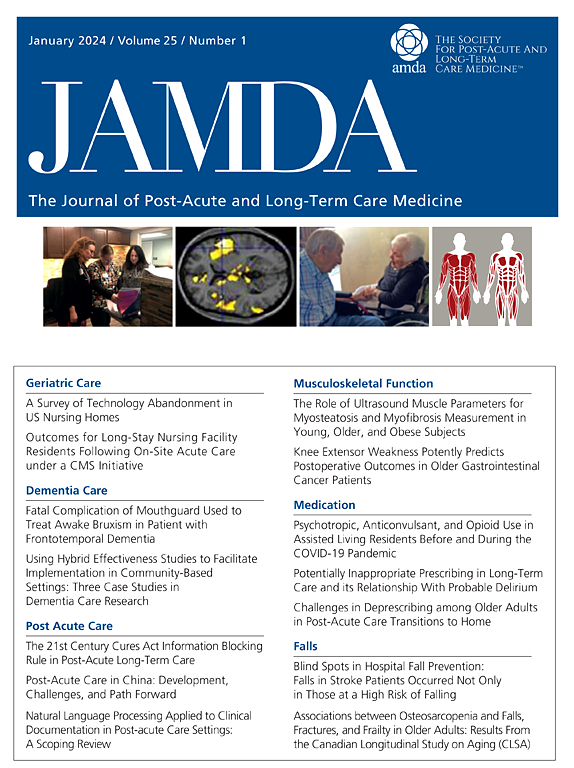Statins Reduce Delirium Risk in Older Adults With Type 2 Diabetes
IF 4.2
2区 医学
Q2 GERIATRICS & GERONTOLOGY
Journal of the American Medical Directors Association
Pub Date : 2025-02-22
DOI:10.1016/j.jamda.2025.105490
引用次数: 0
Abstract
Objectives
To evaluate the impact of statins on delirium incidence in older adults with type 2 diabetes mellitus (T2DM), focusing on hydrophilic versus lipophilic statins and dose-response effects.
Design
Retrospective cohort study using propensity score matching and Cox regression analysis, with competing risk analysis to account for mortality.
Setting and Participants
A total of 110,090 older adults (aged ≥65 years) with type 2 diabetes mellitus identified from Taiwan's National Health Insurance Research Database (2008–2021), including 55,045 statin users and 55,045 matched non-users.
Methods
Delirium incidence was compared between statin users and non-users, adjusting for potential confounders. Analyses evaluated the differential effects of hydrophilic and lipophilic statins and assessed the dose-response relationship using cumulative daily doses.
Results
Statin use significantly reduced delirium risk [adjusted hazard ratio (aHR), 0.73; 95% confidence interval (CI), 0.67–0.79; P < .0001]. Hydrophilic statins showed greater protection (aHR, 0.67; 95% CI, 0.59–0.76) compared with lipophilic statins (aHR, 0.76; 95% CI, 0.69–0.82). Higher cumulative doses were associated with greater risk reductions, with the highest dose quartile (Q4) demonstrating an aHR of 0.36 (95% CI, 0.30–0.43). The incidence rate ratio (IRR) was 0.70 (95% CI, 0.65–0.76; P < .0001).
Conclusions and Implications
Statins, particularly hydrophilic types and higher doses, significantly reduce delirium risk in older adults with type 2 diabetes mellitus. These findings support statins’ role in mitigating cognitive decline and improving outcomes in this population, with implications for clinical practice and future research.
目的:评估他汀类药物对 2 型糖尿病(T2DM)老年人谵妄发生率的影响:评估他汀类药物对2型糖尿病(T2DM)老年人谵妄发生率的影响,重点关注亲水性与亲脂性他汀类药物以及剂量反应效应:设计:回顾性队列研究,采用倾向评分匹配和 Cox 回归分析,并进行竞争风险分析以考虑死亡率:从台湾国民健康保险研究数据库(2008-2021年)中筛选出110,090名患有2型糖尿病的老年人(≥65岁),包括55,045名他汀类药物使用者和55,045名匹配的非使用者:谵妄发生率在他汀类药物使用者和非使用者之间进行了比较,并对潜在的混杂因素进行了调整。分析评估了亲水型他汀类药物和亲脂型他汀类药物的不同作用,并使用累积日剂量评估了剂量-反应关系:使用他汀类药物可明显降低谵妄风险(调整后危险比 [aHR],0.73;95% 置信区间 [CI],0.67-0.79;P < .0001)。与亲脂性他汀类药物(aHR,0.76;95% CI,0.69-0.82)相比,亲水性他汀类药物的保护作用更大(aHR,0.67;95% CI,0.59-0.76)。累积剂量越高,风险降低幅度越大,最高剂量四分位数(Q4)的 aHR 为 0.36(95% CI,0.30-0.43)。发病率比(IRR)为 0.70 (95% CI, 0.65-0.76; P < .0001):他汀类药物,尤其是亲水性类型和较大剂量的他汀类药物,可显著降低2型糖尿病老年人的谵妄风险。这些研究结果支持他汀类药物在缓解该人群认知功能衰退和改善预后方面的作用,对临床实践和未来研究具有重要意义。
本文章由计算机程序翻译,如有差异,请以英文原文为准。
求助全文
约1分钟内获得全文
求助全文
来源期刊
CiteScore
11.10
自引率
6.60%
发文量
472
审稿时长
44 days
期刊介绍:
JAMDA, the official journal of AMDA - The Society for Post-Acute and Long-Term Care Medicine, is a leading peer-reviewed publication that offers practical information and research geared towards healthcare professionals in the post-acute and long-term care fields. It is also a valuable resource for policy-makers, organizational leaders, educators, and advocates.
The journal provides essential information for various healthcare professionals such as medical directors, attending physicians, nurses, consultant pharmacists, geriatric psychiatrists, nurse practitioners, physician assistants, physical and occupational therapists, social workers, and others involved in providing, overseeing, and promoting quality

 求助内容:
求助内容: 应助结果提醒方式:
应助结果提醒方式:


